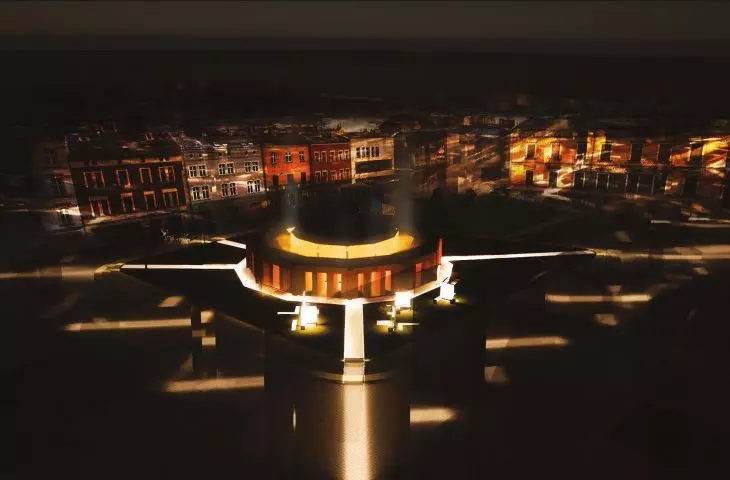New Mosaic
proj.: Oliwia Tasiemska, Patrycja Molska (ASP), Maria Jamróz, Maria Tylek (IS UJ), Bartłomiej Miłosz (IG UJ), Patrycja Mazur, Nika Muzyk (AGH)
[excerpt from author's description]
The proposed vision for Plac Nowy is an open, friendly, engaging space accessible to everyone. The designed changes are intended to emphasize locality, to be a center of entertainment and culture for the residents of Kazimierz. The character of the market will change to promote responsible shopping that opposes mass production. The square has been enriched with a mosaic motif characteristic of the synagogue's decor, which not only emphasizes the presence of Jewish culture, but also reveals the complicated past of the place. The introduced color scheme activated by both artificial and natural light also has connotations related to chromotherapy called color therapy. In this case, it has been proposed to publicly treat any stress with color, stimulating the indicated moods, well-being and atmosphere, so important in our geographical climate. In addition, the space has been upgraded with places designed for relaxation. It symbolizes the function of the place as an integral, active part of human life.
See the full presentation of the project: board 1, board 2, board 3, board 4
WATER GATE
proj.: Urszula Kraszewska, Kacper Góra (ASP), Jan Włodek, Magda Krzemień (IS UJ), Kinga Gwiazda (IG UJ), Zuzanna Żarniewska (AGH)
[excerpt from author's description]
The concept is to open the square to new possibilities, but also not to impose them. The authors of the project decided to treat the New Square as a space that adapts to the changing needs of users regardless of their main motivation and purpose. In this way, moderation, so important to the concept of disrost creating only what is absolutely necessary, is also maintained. The new idea for the redevelopment of New Square includes panels that use water and are covered with appropriately resilient vegetation. They are assumed to work together, using runoff water, moving it, putting it into circulation and thus irrigating the previously mentioned flora. Such a solution will not only help improve the biometeorological comfort in the square, but will also allow the use of natural resources in the city space and draw attention to their importance. The introduced solutions respond to the needs related both to ecological issues aimed at increasing the comfort of the residence (such as the use of natural resources in the form of mosses overgrowing the benches, circular use of water), and also meet the needs arising from social relations [...].
See the full presentation of the project: board 1, board 2, board 3, board 4, board 5, board 6, board 7
workshop conclusions
All the teams at the basis of design assumed "to make the space of New Square a partner of active existence", ultimately showing this place in its new architectural solutions, as an active side of meeting with the user. On the part of the workshop leaders, the thesis was put forward that it's high time to accept that maybe "space doesn't need us and our order" in such an intense dimension of appropriation as it has been so far, all in order to change the course we have given our planet to nowhere for a considerable period of time.... An equally important aspect of didactics in the workshop meetings is for future artists to expand their ranges of critical sensitivity through their own spatial imagination [...].
WATER GATE project
Team: Urszula Kraszewska, Kacper Gora, Jan Włodek, Magda Krzemień, Kinga Gwiazda, Zuzanna Żarniewska
It should be emphasized that all projects have taken a bio/geo/ecocentric perspective in their formal solutions. Some of them have the hallmarks of very concretely materialized spaces, even real, while others may seem too imaginary to our viewers, but only to those whose viewing perspective is too narrowly shaped. It is important that the projects in their ideological concepts have implemented a clear cultural-creative potential through forms filled with important and non-standard content. The realized ideas would certainly be causal in terms of ennobling the users and the place, activating to reflexivity in everyday life, both individual and social [...]. It is obvious for young designers that the activity of the viewer, mainly the reflective one, is also mediated by structural solutions that occupy a specific location in space. To top it off, when they operate according to standards, they are invisible to us, but it is enough for them to lose their obviousness for us to start noticing them. And it is this process of attentiveness that is important for the authors of essential spaces projects. Its idea boils down to a culture of behavior, activated by the reflective approach and awareness of the user—we are talking about a culture of being in these our daily practices!—concludes Prof. Dr. Beata Gibała-Kapecka.
The following are responsible for the implementation of the NEW SPACE 2022 workshop: Prof. Dr. Beata Gibała-Kapecka, M.Sc. Kaja Czajczyk WAW ASP in Krakow, Dr. Marta Smagacz-Poziemska Prof. UJ, Dr. Marcjanna Nóżka Prof. UJ, Dr. Agnieszka Ozga Prof. AGH, Dr. Jarosław Działek, Dr. Tadeusz Kamiński Prof. AGH, M.Sc. Aleksandra Chojak, Dr. Adam Pilch. Dr. Jacek Wierzbicki, Ph.D., and Joanna Hańderek, Ph.D., Prof. UJ, were also invited to cooperate.






















































































